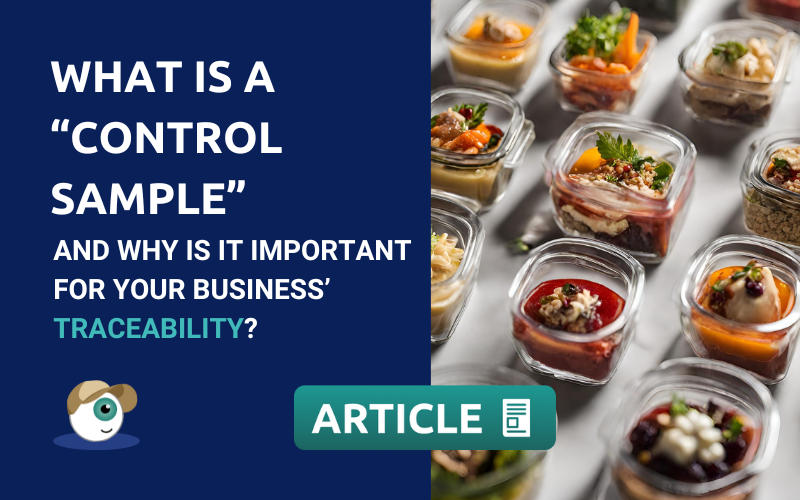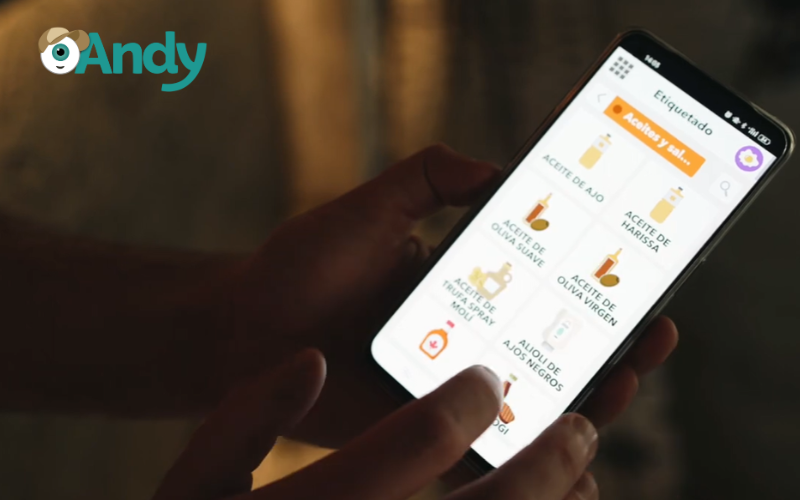What is a “Control Sample” and Why Is It Important for Your Business’ Traceability?

Have you heard of the term “Control Sample“?
No?
In that case, keep reading!
In this article, we will explain what a Control Sample is, why it is crucial for the traceability of your food and the potential detection of contamination and/or foodborne outbreaks.
And if the concept of a control sample sounds familiar, stay tuned and discover how to manage any food-related incidents in the simplest and most efficient way possible.
What Is a Control Sample?
A control sample is a food sample prepared and maintained as a reference in a controlled environment without subjecting it to any manipulation.
The goal is to later compare it with other food samples in the event of possible contamination or deterioration.
In other words, a control sample serves as a kind of “control” or “reference” to compare its condition with that of other foods in case of suspected contamination or alteration.
For example, if there is suspicion that a batch of meat has been contaminated with bacteria, it can be compared with the control sample to determine if there have been any changes in appearance, smell, or taste that may indicate the presence of bacteria.
Control samples are crucial tools in quality control and food safety as they allow for the rapid identification of any issues that may arise in food and the implementation of measures to prevent them from being served to consumers.
They are also useful in investigating outbreaks of foodborne diseases, as they enable the identification of the contamination source and the implementation of measures to prevent future outbreaks.

How Is a Control Sample Prepared and Stored?
The preparation and storage of a control sample depend on the type of food used as a sample and the environmental conditions in which it will be stored.
Here are some general guidelines for preparing and storing a control sample:
- Food Selection: The control sample should be a representative sample of the product being produced. It is essential to select a sample that is as similar as possible in terms of origin, processing, production date, and storage conditions to the samples that will be analysed.
- Preparation: The control sample should be prepared under the same conditions as the test samples. The same preparation technique and utensils used for the test samples should be employed.
- Labelling: Clear llabeling of the control sample is crucial, indicating the production date, type of food, and any other relevant information.
- Storage: The control sample should be stored in a controlled environment, under conditions similar to those of the test samples. It is recommended to store the control sample in an airtight container, protected from light and moisture, in a separate area from the test samples.
- Monitoring: Regular monitoring of the control sample is necessary to detect any signs of contamination or deterioration. If there is suspicion that the control sample has been contaminated, it should be analysed immediately to determine if there have been any changes in appearance, smell, or taste.
Control samples should be collected at the time of service, identified and dated, and stored in refrigeration or freezing for at least seven days. The quantity should be at least 100g per individual portion.
Is It Mandatory to Keep a Control Sample in the Food Industry?
n many countries, regulations in the food industry require the maintenance of a control sample as part of the quality control and food safety program. However, specific regulations vary by country and region.
For instance, in the United States, the Food and Drug Administration (FDA) does not specifically mandate the use of a control sample but does require a quality control plan that includes measures to ensure the accuracy and consistency of food sample analysis results.
On the other hand, the European Union mandates that food companies implement a quality control system that includes the use of reference samples for controlling production processes and detecting contamination. This reference sample could be considered a form of a “control sample.”
While the use of a control sample may not be mandatory in all food regulations, it is a valuable tool to ensure the quality and safety of food. Companies in the food industry may choose to use control samples voluntarily as part of their efforts to enhance quality control and food safety.

Why Are Control Samples Important for Business Traceability?
Traceability is the ability to track a food product through all stages of the supply chain, from its origin to its final destination. It is crucial for ensuring food safety and product quality, especially in the case of foodborne disease outbreaks or product recalls.
Control samples are essential for business traceability because they enable the comparison of a sample from a product that has been recalled or found in violation with a sample from the same batch that has been kept under safe and controlled conditions. This helps determine the cause of the problem and take measures to prevent future issues.
Also, the control sample can be used in follow-up investigations to determine how a product was contaminated and at what point in the supply chain the contamination occurred.
In summary, the control sample is a vital tool in business traceability, ensuring food safety and product quality.
What Measures Should Be Taken If Contamination Is Detected in the Control Sample?
If contamination is detected in the control sample, it is crucial to take immediate measures to protect food safety.
Here are some actions that can be taken:
- Isolate the Control Sample: If contamination is suspected, immediately isolate the control sample from other food samples and place it in a separate container.
- Analiyse Contamination: Conduct an analysis of contamination in the control sample to determine the type and severity of contamination.
- Determine the scope of contamination: Establish whether the contamination is limited to the control sample or if it has affected other food products. If widespread contamination is found, take steps to isolate and eliminate all affected samples.
- Identify the source of contamination: Investigate the source of contamination and take corrective actions. If contamination results from poor hygiene practices, implement measures to enhance cleaning and disinfection procedures.
- Notify Relevant Authorities: In many countries, food businesses are obligated to inform relevant authorities in case of food contamination.
- Implement Corrective Actions: Take corrective actions to eliminate contamination and ensure food safety. These measures may include removing contaminated food, adjusting production procedures, increasing the frequency of quality testing, and improving staff training.

How to Prevent Incidents or Food Crises with Andy?
Preventing incidents or food crises in your kitchen begins with proactive measures and self-control.
Andy, the leading food safety digital assistant is the ideal tool to manage self-control in your food safety processes and prevent potential incidents or food crises.
Big brands in organised catering and franchises all over the world trust Andy to guide their teams in ensuring food safety in their kitchens – from Domino’s Pizza, to NewRest, Starbucks, and many more.

Andy guides teams in their kitchens in a friendly and intelligent manner, preventing issues, caring, and ensuring quality work is done in the shortest time possible.
Andy digitizes all actions related to food safety processes, traceability, labeling, and workspace hygiene, significantly reducing the time the team dedicates to them and facilitating the flawless compliance of all mandatory HACCP and hygiene records.
Here are some tasks that Andy helps with to keep kitchens in any establishment safe and free from consumer risks:
1. Digital HACCP
Andy digitizes cleaning and hygiene records, maintenance, temperatures, and any necessary checklists, ensuring they are always in compliance with the law.
With Andy’s digital HACCP, all mandatory records can be fulfilled while automatically activating corrective plans, streamlining operations from temperature monitoring to corrective actions, setting acceptable limits, and surveillance frequency.
Andy guides teams and ensures that procedures are carried out correctly and always on time.
👉Learn more about Digital HACCP with Andy👈
2. Incident Management
Andy automates any incident that occurs in a commercial kitchen with simple and effective corrective plans. Andy has the power to help resolve arising discrepancies and activate the correct action plan in a fraction of the time kitchen teams usually invest.
Through an efficient notification system, any incident becomes a non-issue in record time!
👉Discover how incidents are automated with Andy👈
4. Internal Audits
With the integrated audit plan in Andy, you can control participant access, customise scores, and gather all inspections in one place.
👉Find out more about automating your audits with Andy👈
5. Food Labelling
Andy’s efficient restaurant operations software also has the ability to label products and ingredients much faster and simpler, ensuring greater food safety in all types of kitchens.
Why not try the numerous advantages that the leading food safety digital assistant
in the food service and hospitality industries
can bring to your kitchens?
👉START YOUR FREE TRIAL HERE👈


